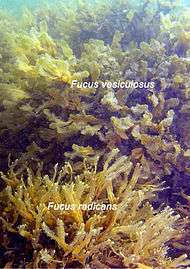Fucus radicans
| Fucus radicans | |
|---|---|
| Scientific classification | |
| (unranked): | SAR |
| Superphylum: | Heterokonta |
| Class: | Phaeophyceae |
| Order: | Fucales |
| Family: | Fucaceae |
| Genus: | Fucus |
| Species: | F. radicans |
| Binomial name | |
| Fucus radicans L. Bergström & L. Kautsky, 2005 [1] | |
Fucus radicans is a species of brown algae in the family Fucaceae, endemic to and recently evolved within the Baltic Sea. The species was first described by Lena Bergström and Lena Kautsky in 2005 from a location in Ångermanland, Sweden. The specific epithet is from the Latin and means "rooting", referring to the fact that this species primarily reproduces by the taking root of detached fragments.[2]

Fucus radicans seems to have diverged from the closely related and widely distributed Fucus vesiculosus within about the last 400 years. It often reproduces clonally, which may have helped its rapid emergence as a new species. Genetic analysis supports the hypothesis of the recent divergence of Fucus radicans from Fucus vesiculosus as an example of sympatric speciation, with the two species presently occupying the same semi-marine territory.[3]
Description
Fucus radicans is morphologically similar to bladderwrack (Fucus vesiculosus) which is dichotomously branched, and has brown leathery fronds known as thalli with a prominent midrib and globular air bladders. The main differences between the two are that plants of F. radicans are smaller and more bushy than F. vesiculosus and have narrower thalli. Bladderwrack is common on the foreshore on both sides of the temperate North Atlantic and the subarctic. F. radicans is endemic to the Baltic Sea, where it grows alongside F. vesiculosus.[3]
The Baltic Sea and speciation
The Baltic Sea was formed by the retreating ice after the last ice age, about ten thousand years ago. At first it was a freshwater lake but the sea broke through on more than one occasion. From about 4,000 years ago till the present time it has been a brackish water area, relatively isolated from the North Sea with only occasional inflows of oceanic water. Over 200 rivers flow into the Baltic and this results in the surface layers being much less saline than other seas. There is a certain amount of inflow of water from the North Sea but this remains on the bottom and relatively unmixed with the surface waters.[4] F. radicans is endemic to the Baltic Sea, where it grows in shallow water alongside F. vesiculosus. It seems to be specially adapted to low salinity levels and unable to tolerate the higher levels of salinity to which other species of seaweed are habituated. Even within the Baltic, salinity levels vary and F. radicans favours the northernmost part, the Gulf of Bothnia, where the brackish water may have a salinity of less than 10‰ [3] (the open ocean has an average of 35‰).[5]
Being intermediate between sea and fresh water, the Baltic Sea, and especially the Gulf of Bothnia, has a low biodiversity and supports only a small number of plant and animal species that have been able to adapt to this level of salinity. Those that are present tend to be smaller than in their main habitats, be those marine or freshwater biomes.[4] Bladderwrack (F. vesiculosus) has a wide distribution and is present in quantities in the Baltic Sea where it lives side by side with the very similar F. radicans. Studies to find their evolutionary relationship using chloroplast (RuBisCO gene) or mitochondrial DNA (intergenic spacer) sequence markers have been inconclusive. Genetic analysis using microsatellite markers (short DNA sequences) suggests that a divergence between the two species occurred between 125 and 2475 years ago with a posterior distribution peak at around 400 years ago. This means the species would have diverged more recently than the transition of the Baltic Sea from a marine environment to its present brackish state. This hypothesis is supported by the fact that F. radicans is found nowhere else other than the Baltic.[3]
An isolating mechanism between the two species may be the fact that F. vesiculosus normally reproduces sexually whereas F. radicans shows a much greater tendency to reproduce asexually, with detached fragments having the ability to take root and develop into new plants. Environmental stress, in this instance the decrease in salinity of the water, has been shown to contribute to the formation of new species. Another contributor to speciation is the evolutionary pressure applied by the change in the environment.[3]
References
- ↑ Guiry, M.D. (2010). "Fucus radicans L. Bergström & L. Kautsky, 2005". World Register of Marine Species. Retrieved 2012-02-29.
- ↑ Fucus radicans L.Bergström & L.Kautsky AlgaeBase. Retrieved 2012-02-29.
- 1 2 3 4 5 Pereyra, R.T.; L. Bergström, L. Kautsky; K. Johannesson (2009). "Rapid speciation in a newly opened postglacial marine environment, the Baltic Sea". BMC Evolutionary Biology. 9 (70). doi:10.1186/1471-2148-9-70.
- 1 2 The Baltic Sea:Its Past, Present and Future Jan Thulin and Andris Andrushaitis. Retrieved 2012-02-29.
- ↑ Ocean Water: Salinity Science and Technology Focus. Retrieved 2012-03-03.